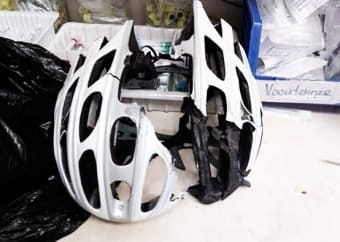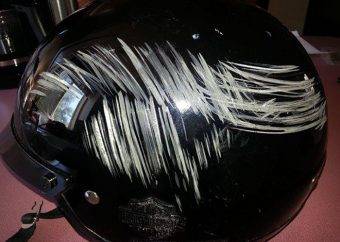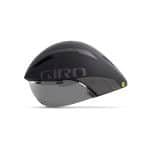After years of being a biker, I finally decided to provide you my 18 reasons why we all need to wear a bike helmet. Whether you are a casual biker or a competitive biker, a well-fitted biking helmet is a must. You want a helmet that is made specifically for biking, that fits nicely around your head, and that protects your forehead without blocking your vision. Knowing what to look for when you try on various styles will ensure your helmet is comfortable, as well as safe.
Why you should wear a bike helmet?
I think the picture says it all.

Here are the 18 most common reasons why you should wear a bike helmet:
- They protect your brain from traumatic injury during a collision.
- Helmets protect your skull from head blows.
- They limit potential internal injuries.
- A bike helmet protects your teeth.
- A full-face helmet protects your gums.
- Any approved helmet protects your scalp.
- They protect your ears.
- You can protect your eye and eyelashes with an on-road/off-road helmet.
- They protect your skin/face injuries.
- Helmets improve visibility for others.
- Improve your vision (no flies and insects in your eyes with the visor shield) and hearing as it cancels out distract noise.
- Keeps your head warm and dry during wet conditions.
- It allows you to claim insurance in the case of an accident (this is a pre-requirement).
- When you wear your helmet and have an accident, it will surely reduce your medical bills.
- It allows you to abide by the law.
- By wearing a helmet, you set an example for your children, but also for other people’s kids.
- It provides some style, though style should be secondary to safety.
- A bike helmet gives you that extra sense of comfort.
By the way, you can find some cool offroad helmets here.
The importance of wearing a helmet
There is no magic bullet, no magic formula when it comes to helmet safety. What matters most is that you have a helmet that meets state and national safety standards. Make sure you choose a bike helmet that is approved by the U.S. Consumer Product Safety Commission (CPSC) or by any of your country’s safety organizations (a recognized one in Europe is CE).

I think you would consider avoiding helmets that are too small, and therefore too tight to provide sufficient protection. You should also avoid those that are too large. It is, therefore, best to find an adjustable helmet. Note that no helmet will keep a rider completely safe from injury in the event of an accident. But, the latest helmet technologies rely on state-of-the-art materials and lightweight construction to mitigate the impacts of a crash, hence reducing the injuries and in most cases saving your life.
Bike helmets are for safety, not only for style
One thing to keep in mind: don’t be fooled by the cheap and flimsy-looking helmets. A quality helmet for biking will protect your skull from being broken when it collides with a car or another bike. They will also protect you from being struck by passing birds, trees, branches, and other objects. It’s not better to wear a cheap helmet that doesn’t protect you and gets you killed while riding a bike than to wear an expensive, but top-of-the-range safety helmet and stay safe.

In essence, a helmet is not designed for stylish type biking. Its primary purpose is to keep your head and face protected during a fall or crash. Helmets made only from plastic are less protective than helmets that are made of a combination of foam and fiberglass. I believe that if you are looking to buy a helmet, then it’s also important to know that different people have different comfort levels when it comes to using a protective helmet. So take your time before buying a helmet.
How to find the right helmet?
This is the million-dollar question really. What you best need is a helmet that provides you with good head movement while biking. This is definitely key to your comfort before using your bike. You need a helmet that does has an adjustable fastening so that you can adapt it to your needs.
For people that are serious about biking, you want to ensure that when you lean into turns, the helmet stays in place and doesn’t move. If it moves, you may end up blind with one eye and not see what’s in front of you. Be careful of this trap.

I have been biking for many years and I can tell from experience that vents to allow fresh air to circulate around the head and eyes are critical. Without this, you’ll get tired, sweaty, and probably dizzy. So, ensure you have a helmet with appropriate ventilation. Wearing a helmet with venting allows hot air and heat to escape the helmet. Also, if you wear a helmet that doesn’t have venting, the hot air will stay inside, build up and create a lot of heat. How comfortable is this?
What is the difference between an off-road and on-road cycling helmet?
An off-road cycling helmet is usually designed to be used for riding on dirt, gravel, and other unpaved surfaces. This type of helmet is in most cases of an egg-type form, without a visor and with plenty of holes for airflow purposes. The helmet is usually made of hard plastic and foam and is simpler and cheaper than on-road helmets. The reason is that the potential accidents for an off-road biker are less risky than an on-road accident.

An on-road helmet is usually designed to withstand high-speed shocks and is more round, with a visor and a long tail to protect the rider’s neck. The designer takes into account that the most likely on-road accidents will lead to a major head injury. As such, the designer tries to alleviate this through different ways, more foam, harder outer shell, face visor, etc. I mean the helmet must be designed to protect against a wider variety of accidents: those that involve a fall at high speed, a jump, or a collision with a car, etc.
All in all, an on-road helmet is more secure than off-road, though you can have very strong offroad helmets for professional bikers.
Consider the features of the helmet
First, think about the specific features of your helmet that matter most to you and your safety. Most helmets are shaped like spheres, but there are specific shapes, like the egg too (which I do not really like to be honest). And some helmets are one-piece that stays in place with a tight rubber or plastic seal around the back of your head.

There are a number of bike helmets that have adjustable straps so you can easily fit your head comfortably, without restricting your breathing. Because there are so many types of helmets, you’ll want to shop for a specific style that matches your lifestyle. I like helmets that have a rear suspension system to protect your noggin. I also like helmets that are highly adjustable. And the feature that I would always want mirrors, though this is very specific. I quite like helmets that have lights on them so that I can be seen from far away, but they are also cool. By the way, some helmets have reflective or glow-in-the-dark – sound cool – isn’t it? And do not forget to wear some nice protective gloves.
How to size the helmet?
Many biking helmets are available in three different sizes: small, medium, and large. Do your research to figure out what size of the helmet you want and which size fits your head beat. And be careful, sizes may differ from one helmet manufacturer to another one.
A too-small helmet will lead to an ill-fitting helmet that will lead to headaches and maybe even worse injury, like a concussion for a small short with a bird or tree branch.

The length and width of your bike helmet should fit comfortably. However, it should also not constrict your head to make your helmet sag down around your eyes. As much as a too-small helmet is bad for you, a too big one can also lead to major issues. If you have a too big helmet, then it may move when you are biking and cause you to potentially lose balance because you lose focus.
When to replace a biking helmet?
Bike helmets should be replaced at least every six years. This is because the inner of the helmet will become weaker. However, it is not recommended that you remove and replace a helmet if you’ve only ridden your bike with it just a few times. Should your helmet has some bumps, scratches, or other minor damage, it is imperative that you replace it.
Conclusion
There are many reasons you need to wear a bike helmet, but the list above is a good place to start. In fact, I provided you with 18 reasons, and so if you are not convinced of the need to wear a helmet, then you really need to question yourselves and your behavior towards safety.
Simply put from me to you, wear a helmet all year round, not just during the winter months. Remember, no matter your age or the age of your children, you’ll all need a bike helmet. Also, make sure you’ll have protective eyewear so you can all see around you when the sunshine is really shiny.
References:
1- https://www.boredpanda.com/reasons-why-wearing-helmet-is-important/








